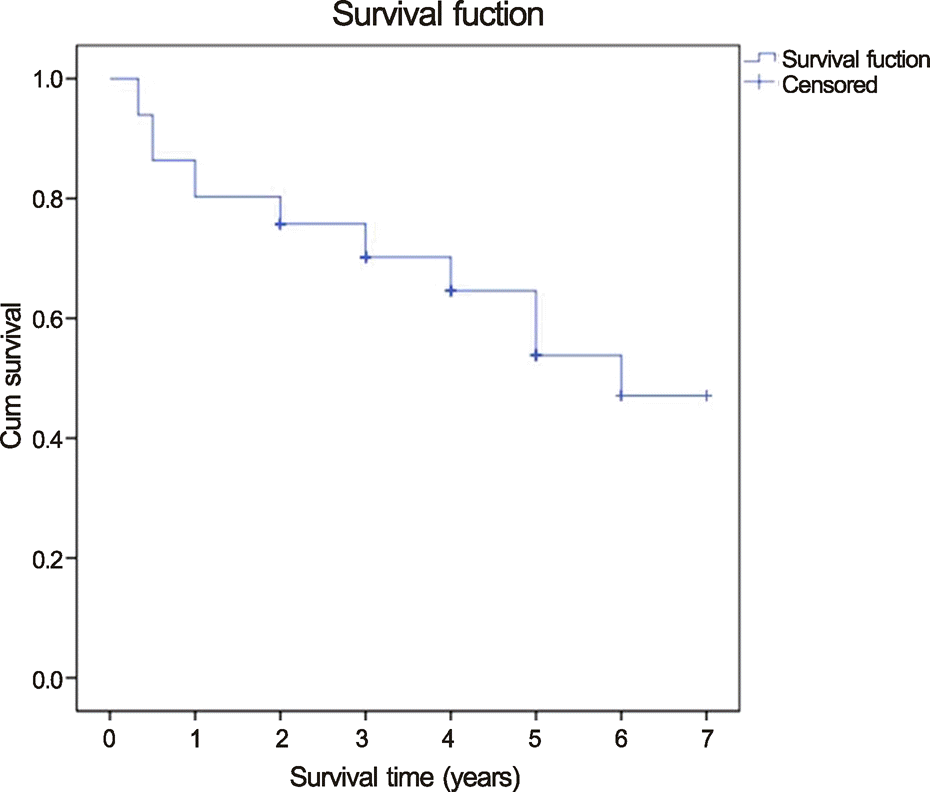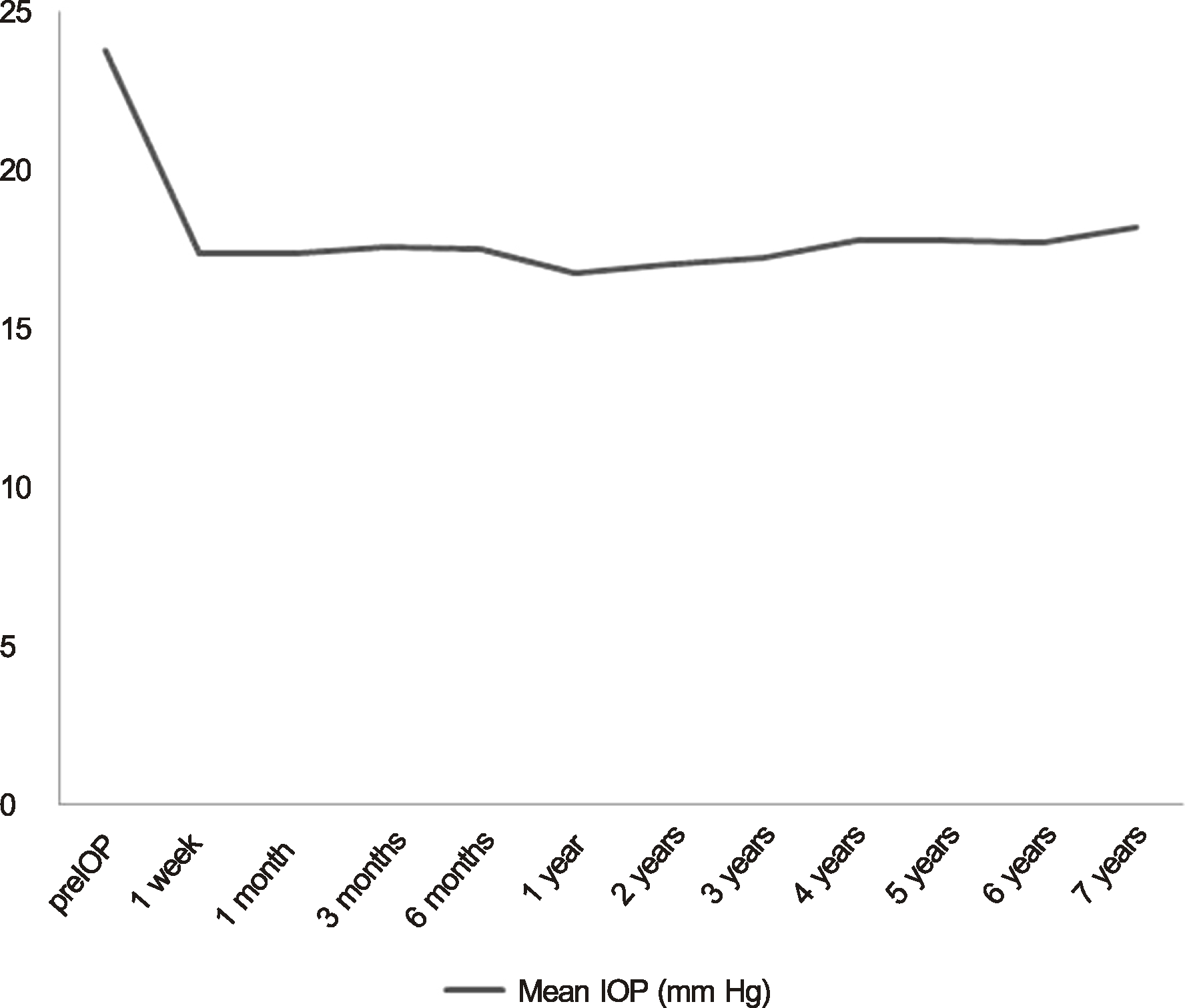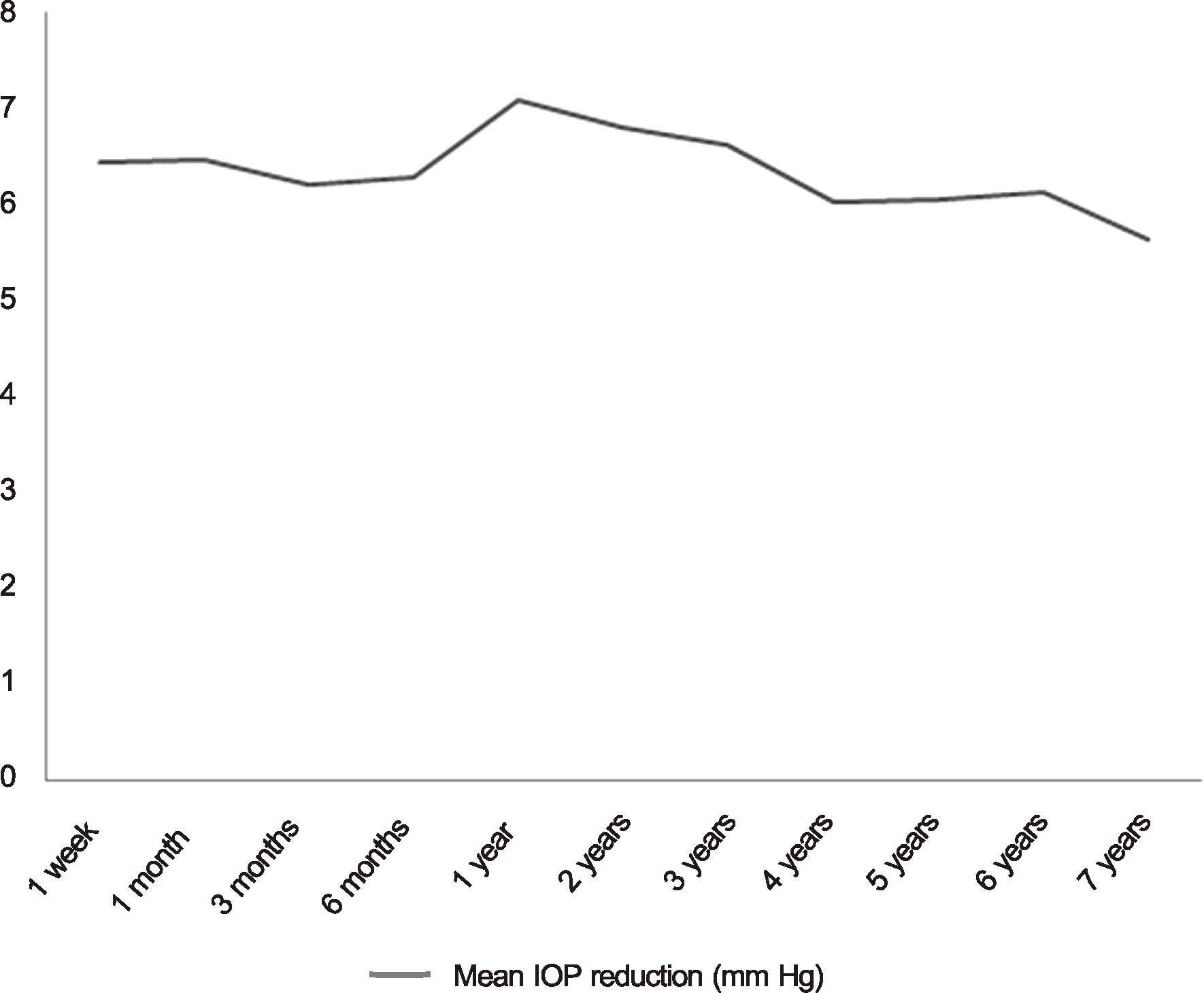Abstract
Purpose
To investigate long-term outcomes and predictive success factors for selective laser trabeculoplasty (SLT).
Methods
This retrospective chart review included 66 eyes of 66 glaucoma or ocular hypertension patients who underwent SLT between 2004 and 2011. All patients were followed-up for at least 2 years after the procedure. The intraocular pressure (IOP) was measured before the treatment, at postoperative 1 week, 1 month and every 3 months thereafter. Success was defined as an IOP decrease ≥ 3 mm Hg or ≥ 20% of the pretreatment IOP. The success rate was determined based on the Kaplan-Meier survival analysis. The predictive success factors were analyzed using the Cox proportional hazard model.
Results
The mean follow-up period was 4.78 ± 1.98 (2-8) years. The mean pretreatment IOP was 23.79 ± 2.83 mm Hg. The mean IOP reduction was 6.64 ± 3.21 mm Hg. The success rates were 80%, 75%, 69%, 63%, 50%, 45%, and 42% after 1, 2, 3, 4, 5, 6, and 7 years, respectively. Only high pretreatment IOP was significantly correlated with success (p = 0.044).
Go to : 
References
2. Kass MA, Heuer DK, Higginbotham EJ, et al. The Ocular Hypertension Treatment Study: a randomized trial determines that topical ocular hypotensive medication delays or prevents the onset of primary open-angle glaucoma. Arch Ophthalmol. 2002; 120:701–13. discussion 829-30.
3. Heijl A, Leske MC, Bengtsson B, et al. Reduction of intraocular pressure and glaucoma progression: results from the Early Manifest Glaucoma Trial. Arch Ophthalmol. 2002; 120:1268–79.
4. Wise JB, Witter SL. Argon laser therapy for open-angle glaucoma. A pilot study. Arch Ophthalmol. 1979; 97:319–22.
5. The Glaucoma Laser Trial (GLT) and glaucoma laser trial follow-up study: 7. Results. Glaucoma Laser Trial Research Group. Am J Ophthalmol. 1995; 120:718–31.
6. Brubaker RF, Liesegang TJ. Effect of trabecular photocoagulation on the aqueous humor dynamics of the human eye. Am J Ophthalmol. 1983; 96:139–47.

7. Melamed S, Pei J, Epstein DL. Delayed response to argon laser trabeculoplasty in monkeys. Morphological and morphometric analysis. Arch Ophthalmol. 1986; 104:1078–83.
9. Van Buskirk EM, Pond V, Rosenquist RC, Acott TS. Argon laser trabeculoplasty. Studies of mechanism of action. Ophthalmology. 1984; 91:1005–10.
10. Kramer TR, Noecker RJ. Comparison of the morphologic changes after selective laser trabeculoplasty and argon laser trabeculoplasty in human eye bank eyes. Ophthalmology. 2001; 108:773–9.

11. Pham H, Mansberger S, Brandt JD, et al. Argon laser trabeculoplasty versus selective laser trabeculoplasty. Surv Ophthalmol. 2008; 53:641–6.
12. Feldman RM, Katz LJ, Spaeth GL, et al. Long-term efficacy of repeat argon laser trabeculoplasty. Ophthalmology. 1991; 98:1061–5.

13. Fink AI, Jordan AJ, Lao PN, Fong DA. Therapeutic limitations of argon laser trabeculoplasty. Br J Ophthalmol. 1988; 72:263–9.

14. Latina MA, Sibayan SA, Shin DH, et al. Q-switched 532-nm Nd:YAG laser trabeculoplasty (selective laser trabeculoplasty): a multicenter, pilot, clinical study. Ophthalmology. 1998; 105:2082–8. discussion 2089-90.
15. Damji KF, Bovell AM, Hodge WG, et al. Selective laser trabeculoplasty versus argon laser trabeculoplasty: results from a 1-year randomised clinical trial. Br J Ophthalmol. 2006; 90:1490–4.

16. Damji KF, Shah KC, Rock WJ, et al. Selective laser trabeculoplasty v argon laser trabeculoplasty: a prospective randomised clinical trial. Br J Ophthalmol. 1999; 83:718–22.

17. Juzych MS, Chopra V, Banitt MR, et al. Comparison of long-term outcomes of selective laser trabeculoplasty versus argon laser trabeculoplasty in open-angle glaucoma. Ophthalmology. 2004; 111:1853–9.

18. Melamed S, Ben Simon GJ, Levkovitch-Verbin H. Selective laser trabeculoplasty as primary treatment for open-angle glaucoma: a prospective, nonrandomized pilot study. Arch Ophthalmol. 2003; 121:957–60.
19. McIlraith I, Strasfeld M, Colev G, Hutnik CM. Selective laser trabeculoplasty as initial and adjunctive treatment for open-angle glaucoma. J Glaucoma. 2006; 15:124–30.

20. Katz LJ, Steinmann WC, Kabir A, et al. Selective laser trabeculoplasty versus medical therapy as initial treatment of glaucoma: a prospective, randomized trial. J Glaucoma. 2012; 21:460–8.
21. Kano K, Kuwayama Y, Mizoue S, Ito N. [Clinical results of selective laser trabeculoplasty]. Nihon Ganka Gakkai Zasshi. 1999; 103:612–6.

22. Weinand FS, Althen F. Long-term clinical results of selective laser trabeculoplasty in the treatment of primary open angle glaucoma. Eur J Ophthalmol. 2006; 16:100–4.

23. Gracner T, Pahor D, Gracner B. [Efficacy of selective laser trabeculoplasty in the treatment of primary open-angle glaucoma]. Klin Monbl Augenheilkd. 2003; 220:848–52.
24. Cvenkel B. One-year follow-up of selective laser trabeculoplasty in open-angle glaucoma. Ophthalmologica. 2004; 218:20–5.

25. Hodge WG, Damji KF, Rock W, et al. Baseline IOP predicts selective laser trabeculoplasty success at 1 year post-treatment: results from a randomised clinical trial. Br J Ophthalmol. 2005; 89:1157–60.

26. Chen E, Golchin S, Blomdahl S. A comparison between 90 degrees and 180 degrees selective laser trabeculoplasty. J Glaucoma. 2004; 13:62–5.
27. Song J, Lee PP, Epstein DL, et al. High failure rate associated with 180 degrees selective laser trabeculoplasty. J Glaucoma. 2005; 14:400–8.

28. Latina MA, Tumbocon JA. Selective laser trabeculoplasty: a new treatment option for open angle glaucoma. Curr Opin Ophthalmol. 2002; 13:94–6.

29. Kajiya S, Hayakawa K, Sawaguchi S. Clinical Results of Selective Laser Trabeculoplasty. Jpn J Ophthalmol. 2000; 44:574–5.

30. Johnson PB, Katz LJ, Rhee DJ. Selective laser trabeculoplasty: predictive value of early intraocular pressure measurements for success at 3 months. Br J Ophthalmol. 2006; 90:741–3.

31. Cvenkel B, Hvala A, Drnovsek-Olup B, Gale N. Acute ultrastructural changes of the trabecular meshwork after selective laser trabeculoplasty and low power argon laser trabeculoplasty. Lasers Surg Med. 2003; 33:204–8.

32. Zaninetti M, Ravinet E. [Two-year outcomes of selective laser trabeculoplasty in open-angle glaucoma and ocular hypertension]. J Fr Ophtalmol. 2008; 31:981–6.
33. Lee HS, Baek NH, Moon JI. Comparison of short-term outcomes of argon laser versus selective laser trabeculoplasty in open-angle glaucoma. J Korean Ophthalmol Soc. 2005; 46:2004–9.
34. Kim JS, Lee YG, Hong YJ. Q-switched, frequency doubled Nd:YAG laser trabeculoplasty. J Korean Ophthalmol Soc. 1999; 40:2591–6.
35. Jang YS, Kim JM, Lim TH, et al. Comparison of 180° and 360° selective laser trabeculoplasty. J Korean Ophthalmol Soc. 2012; 53:291–6.

36. Suhk HJ, Kook MS. Three year follow up of laser trabeculoplasty using Q-switched frequency doubled Nd:YAG laser. J Korean Ophthalmol Soc. 2003; 44:93–9.
37. Moon SJ, Choi ES, Park JI, Lee KH. Two-year follow-up of selective laser trabeculoplasty as initial and adjunctive treatment for ocular hypertension and open Angle glaucoma. J Korean Ophthalmol Soc. 2010; 51:974–80.

38. Lai JS, Chua JK, Tham CC, Lam DS. Five-year follow up of selective laser trabeculoplasty in Chinese eyes. Clin Experiment Ophthalmol. 2004; 32:368–72.

39. Abdelrahman AM, Eltanamly RM. Selective laser trabeculoplasty in Egyptian patients with primary open-angle glaucoma. Middle East Afr J Ophthalmol. 2012; 19:299–303.

40. Lee JH, Seong MC, Cho HY, Lee YJ. The effectiveness of selective laser trabeculoplasty in steroid-induced ocular hypertension. J Korean Ophthalmol Soc. 2011; 52:876–80.

41. Ayala M, Chen E. Long-Term Outcomes of Selective Laser Trabeculoplasty (SLT) Treatment. Open Ophthalmol J. 2011; 5:32–4.

42. Gracner T, Naji M, Hudovernik M, et al. [Predictive factors of successful selective laser trabeculoplasty in open-angle glaucoma]. Klin Monbl Augenheilkd. 2007; 224:922–6.
43. Martow E, Hutnik CM, Mao A. SLT and adjunctive medical therapy: a prediction rule analysis. J Glaucoma. 2011; 20:266–70.
44. Odberg T, Sandvik L. The medium and long-term efficacy of primary argon laser trabeculoplasty in avoiding topical medication in open angle glaucoma. Acta Ophthalmol Scand. 1999; 77:176–81.

45. Ayala M, Landau Högbeck I, Chen E. Inflammation assessment after selective laser trabeculoplasty (SLT) treatment. Acta Ophthalmol. 2011; 89:e306–9.

46. Realini T, Charlton J, Hettlinger M. The impact of anti-inflammatory therapy on intraocular pressure reduction following selective laser trabeculoplasty. Ophthalmic Surg Lasers Imaging. 2010; 41:100–3.

Go to : 
 | Figure 3.Kaplan-Meier survival analysis. The success rate was 82%, 78%, 71%, 64%, 59%, 53%, 43% after 1, 2, 3, 4, 5, 6, 7 years. |
Table 1.
Baseline characteristics
Table 2.
Laser parameters
| Factors | Values |
|---|---|
| Number of spots per eye | 51.27 ± 5.94 |
| Total dose per eye (mJ) | 39.49 ± 6.57 |
| Postopertative medication | |
| Fluorometholone (%) | 42 (63.58) |
| None (%) | 24 (36.42) |
Table 3.
Mean IOP and change in pressure (mm Hg) from pre IOP
| Number of eyes | Mean IOP ± SD (mm Hg) | Mean IOP reduction (mm Hg) (%) | p-value* | |
|---|---|---|---|---|
| PreIOP | 66 | 23.79 ± 2.83 | − | − |
| 1 week | 66 | 17.36 ± 4.12 | 6.43 (27.1) | <0.001 |
| 1 month | 66 | 17.34 ± 4.33 | 6.45 (27.0) | <0.001 |
| 3 months | 66 | 17.59 ± 3.19 | 6.2 (26.1) | <0.001 |
| 6 months | 54 | 17.51 ± 3.02 | 6.28 (26.1) | <0.001 |
| 1 year | 46 | 16.72 ± 2.57 | 7.07 (29.5) | <0.001 |
| 2 years | 40 | 17.01 ± 2.77 | 6.78 (28.5) | <0.001 |
| 3 years | 30 | 17.19 ± 3.11 | 6.6 (27.7) | <0.001 |
| 4 years | 27 | 17.78 ± 3.37 | 6.01 (25.3) | <0.001 |
| 5 years | 18 | 17.75 ± 2.96 | 6.04 (25.4) | <0.001 |
| 6 years | 9 | 17.68 ± 2.12 | 6.11 (25.7) | <0.001 |
| 7 years | 5 | 18.16 ± 3.70 | 5.63 (23.6) | <0.001 |
Table 4.
Comparison of the success group and failure group at 2 years
| Factors | Success group (n = 43) | Failure group (n = 23) | p-value |
|---|---|---|---|
| Age (range) | 54.67 ± 12.64 (39-86) | 50.74 ± 9.31 (30-74) | 0.075* |
| Diagnosis | |||
| POAG | 36 | 21 | 0.742† |
| PXG | 4 | 1 | |
| OHT | 3 | 1 | |
| Family history of glaucoma (%) | 4 (9.3) | 2 (8.7) | 0.686† |
| Hypertension (%) | 9 (20.9) | 6 (26.2) | 0.257† |
| Diabetes (%) | 5 (10.3) | 3 (13.0) | 0.461† |
| MD, median (range) (dB) | −12.02 (-32.04∼0.59) | −8.55 (-32.45∼0.65) | 0.643‡ |
| PSD, median (range) (dB) | 5.12 (1.02-12.18) | 4.86 (0.12-14.69) | 0.578‡ |
| Baseline IOP (range) (mm Hg) | 26.20 ± 4.56 (18-38) | 23.91 ± 5.39 (14-36) | 0.073* |
| Pretreatment IOP (range) (mm Hg) | 25.38 ± 2.68 (17-36) | 20.52 ± 2.61 (13-31) | 0.019* |
| Number of medications before SLT (range) | 3.39 ± 1.53 (0-4) | 4.0 ± 0.80 (0-5) | 0.082* |
| TM pigmentation (range) | 0.17 ± 0.59 (0-2) | 0.27 ± 0.51 (0-2) | 0.650* |
| Total energy (mJ) | 39.03 ± 6.68 | 40.35 ± 6.42 | 0.438* |
| Use of anti-inflammatory medication (%) | 26 (60.5) | 16 (69.6) | 0.248† |
Values are presented as mean ± SD unless otherwise indicated.
POAG = primary open angle glaucoma; PXG = pseudoexfoliation glaucoma; OHT = ocular hypertension; MD = mean deviation; PSD = pattern standard deviation; IOP = intraocular pressure; SLT = selective laser trabeculoplasty; TM = trabecular meshwork.
Table 5.
Predictive factors associated with survival time for SLT
| Covariates | Harzad ratio | 95% CI | p-value* |
|---|---|---|---|
| Age | 0.971 | 0.936-1.005 | 0.093 |
| Pretreatment IOP | 0.838 | 0.739-0.936 | 0.044 |
| Baseline IOP | 0.953 | 0.781-1.125 | 0.335 |
| Number of medications before SLT | 1.361 | 0.943-1.779 | 0.149 |




 PDF
PDF ePub
ePub Citation
Citation Print
Print




 XML Download
XML Download